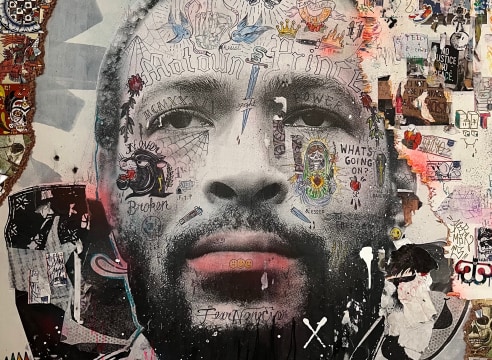
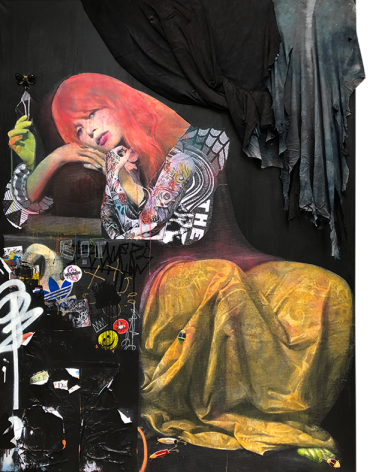
Stikki Peaches "A Pensive Bardot" SOLD
Mixed media on canvas
81.5" x 58"
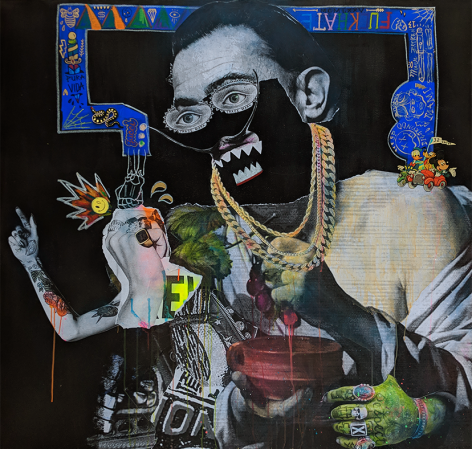
Stikki Peaches "Dali Delirante" SOLD
Mixed media on canvas
60" x 60"
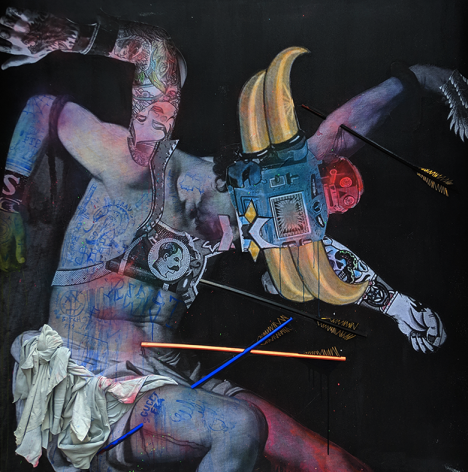
Stikki Peaches "Fallen Hero (Goldorak)" SOLD
Mixed media on canvas
72" x 72"
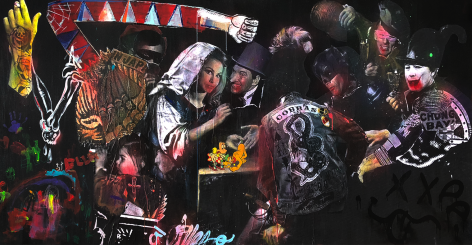
Stikki Peaches "La Famiglia" SOLD
Mixed media on canvas
48" x 96"
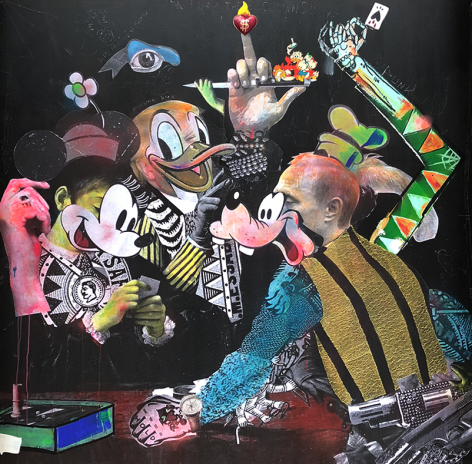
Stikki Peaches "Spy Games" SOLD
Mixed media on canvas
72" x 72"
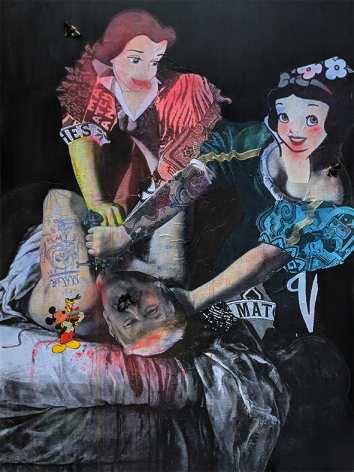
Stikki Peaches "Once Upon a Time in America" SOLD
Mixed media on canvas
84" x 60"
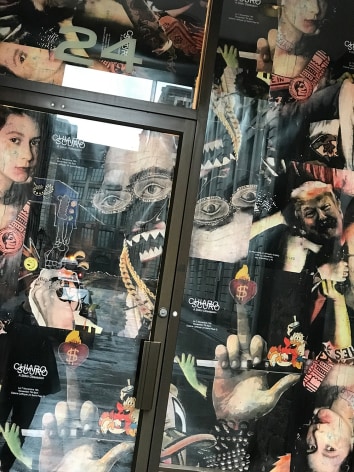
Stikki Peaches | Chiaroscuro | November 2018 | Galerie LeRoyer

Stikki Peaches | Chiaroscuro | November 2018 | Galerie LeRoyer
CHIAROSCURO: A STIKKI OBSESSION
The term Chiaroscuro refers to the painting technique popularized by the radical Italian Baroque artist Caravaggio in the 17th Century. Due to his revolutionary technical development, Caravaggio became one of the most widely imitated painters in the history of western art. Caravaggism represented a realistic combination of physical and emotional use of chiaroscuro lighting to bring high drama to his paintings. His subjects became the vehicles for contrast between light and dark, emphasizing a mix of violence and sexuality. Caravaggio’s remarkable talent was to express the vividness of a crucial, passing moment and to extend the action of his compositions beyond the picture plane and into the viewer’s space.
Freezing a moment in time was a revolutionary concept in 17th century painting. Caravaggio made this technique a dominant stylistic element in all his paintings: darkening the shadowed and transfixing his subjects in blinding shafts of light. This signature chiaroscuro technique became a defining element in Baroque art and was subsequently adopted by other contemporary artists in Italy and across Europe, who eventually came to be known as the School of Caravaggio or, simply, the Caravaggists.
Caravaggio is often called the most modern of old masters; there’s a newness, a contemporary feel to his work. He also used light and cropping techniques like a photographer. He not only inspired the Caravaggists but many contemporary artists today, including Stikki Peaches. Using multi-media techniques including collage, acrylic paint, silkscreen and sculptural elements, Stikki Peaches’ work imbues a POP art sensibility. He’s also clearly inspired by Robert Rauschenberg, who referred to the technique of using 3D sculptural elements, combined with the flat surface of a two-dimensional plane, as Combines. The anonymous street artist was also strongly influenced by Andy Warhol, liberally using pop culture references and mashing up images from childhood memories. Referencing classic film, TV shows, celebrities, musical icons, athletes, super heroes and sometimes not-so-savory politicians, he creates startling juxtapositions of narrative themes, aesthetics and symbolism.
In this exhibition, Stikki Peaches presents 20 new Interpretive Hybrid works inspired by the paintings of Caravaggio and his School. Many of the artist’s favorite iconic characters are present: The Pensive Bardot as Mary Magdalene, his ever-present muse, Kate Moss, as the martyred St. Catharine (No Saint Kate Moss), the full cast of the TV show Friends in one Caravaggio’s most emotional painting The Entombment (Death of Friends). The list goes on with a macabre but heartfelt homage to his favorite musical artists Jim Morrison, Amy Winehouse & Kurt Cobain, who all tragically died at age 27. This piece, originally titled Saint Cecilia with Two Angels by Caravaggio follower Antiveduto Gramatica, is now titled The 27 Club for the obvious reasons. Let’s not forget the comical but tragic St. Jerome (End of the Empire) as Darth Vader or The Lute Player as a psyched-out and surreal Jimmy Hendricks.
One of the largest panels from the show and one of the artist’s most personal and autobiographical works is entitled La Famiglia (The Fortune Teller with Soldiers). On the left side of this massive painting is a representation of the artist’s daughter, drawing a picture of a hand. At the center is the artist himself, pictured from behind, which is a nod to keeping his anonymity even as he attempts a self-portrait. All this with the presence of his favorite Batman characters: Robin, Cat Woman, the Joker, Penguin and, of course, Batman. One of the most politically charged pieces of the show is a painting by Artemisia Gentileschi, a female follower of Caravaggio. At age 18 her tutor, Tassi, raped her; due to the culture at the time, however, people blamed Artemisia for her own rape and her abuser was never charged. Her experience and the trial that followed left her with a strong sense of female empowerment and was the inspiration for her painting Judith Slaying Holofernes. In a scene that is both stark and violent, you see Judith and her maidservant Abra violently severing the general‘s head. Succeeding in slaying their enemy, they emerge as heroines. In Stikki Peaches’ version of the same narrative, which he entitles Once Upon a Time in America, Snow White and Belle, two popular Disney characters, replace Judith and Abra. General Holofernes is President
Donald Trump — evoking a surrealistic, symbolic scene where reality and make believe become one, and feeding into the belief (and hope) that this nightmare fairytale is finally coming to an end! Notably, the artist also commissioned traditional bespoke embroidery artists to create specific, 3D motives of Scarabs and Moths to be inserted in the paintings. In the case of Once Upon a Time in America, the jeweled, black velvet Moth — symbolizing silence and death — is intentionally inserted on the mouth of the villain, President Trump. Consequently, this work can be viewed as a metaphor to parallel the story of female triumph over powerful men. It can also be interpreted as the ultimate act of revenge, a psychological cleansing of the soul. For Stikki Peaches, it was very important to include his take on this particular painting by Artemisia Gentileschi in this exhibition, as an expression of outrage and of solidarity with survivors of sexual assault.
Through a complex process of removal and additions, Stikki Peaches has created for this exhibition, an impressive new body of work based on hybrid reconstructions that draw from the vocabularies of multi-media collage, painting and sculpture, the paintings of Caravaggio and his School, and Rauschenberg’s Combines. Using Chiaroscuro techniques to highlight the drama of his reconstructed narratives and Rauschenberg’s techniques of inserting 3D sculptural elements in his paintings, the artist gives his pieces a distinct sculptural and emotional effect. In doing so, he continues to question and exceed the boundaries between forms. In these 20 Tableau Vivant, the artist’s iconographic childhood heroes intertwine with a hallucinatory mix of images and symbols, saints and martyrs, and results in an immediacy that is rarely seen in 21st century art. Stikki Peaches, captures the zeitgeist of a time when our freedoms and ways of life are threatened by forces out to deceive and corrupt, where truth and facts are in danger of being trivialized. Through his art, and especially with this exhibition, Stikki Peaches is taking a stand against these dark and corrupt powers, proposing that maybe, just maybe… art will indeed save the world.
By : Andre Pace